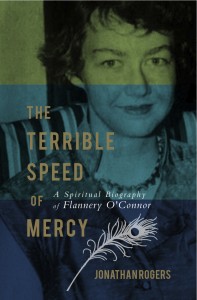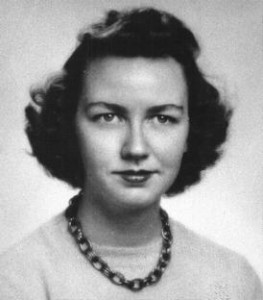Our book reviewer today is Autumn, one of our current interns here at Redeemedreader.com. She is a sophomore at a small liberal arts college here in Tennessee, making her way through a Southern, patient Christ-haunted literary landscape much like Flannery O’Connor encountered. Among her many interests are reading, writing, violin, guitar, songwriting and drinking fermented (non-alcoholic) tea with friends. (I added that last one based on our shared passion, though she has yet to let me try this so-called “fermented” tea.) Most importantly, though, Autumn is a very thoughtful, insightful reader, and I’m so grateful she was willing to share some of those insights with us today.
(P.S. Don’t forget that today is the last day to enter to win a copy of this book here!)
The Terrible Speed of Mercy: A Spiritual Biography of Flannery O’Connor by Jonathan Rogers. Thomas Nelson. 2012. 208 pgs.
 Flannery O’Connor was a woman who wrote of community, enlightenment, grace and ignorance. She portrays both the hypocrites and the “blameless” and then turns them on their heads. She writes about community, about broken community, about community built on money, on gain, on infinite selfishness, and describes situations in which we often do not find ourselves. How can we understand such ideas unless we are confronted with them? If we read what is comfortable, what is easy, then we will not be forced to struggle. In the reading of O’Connor, I often identify myself with the good characters, with the grace giver. and soon enough O’Connor reveals that character’s hollowness or I see I am in fact the misfit, the grandmother. And this is humbling.
Flannery O’Connor was a woman who wrote of community, enlightenment, grace and ignorance. She portrays both the hypocrites and the “blameless” and then turns them on their heads. She writes about community, about broken community, about community built on money, on gain, on infinite selfishness, and describes situations in which we often do not find ourselves. How can we understand such ideas unless we are confronted with them? If we read what is comfortable, what is easy, then we will not be forced to struggle. In the reading of O’Connor, I often identify myself with the good characters, with the grace giver. and soon enough O’Connor reveals that character’s hollowness or I see I am in fact the misfit, the grandmother. And this is humbling.
Jonathan Rogers’ biography The Terrible Speed of Mercy: A Spiritual Biography of Flannery O’Connor expounds on her themes of violence, the grotesque, and mystery. He helps to explain her aims in writing about such dark themes, which is a valid argument against her writing. Why read an author who writes about darkness and sinfulness? The answer to this also enlightens us as to why we ought to read a biography of O’Connor and also her writing. She says that we are familiar with what evil looks like, and we expect evil to be grotesque. She writes, however, “Few have stared at [good] long enough to accept the fact that its face too is grotesque, that in us the good is something under construction.” Her reason for writing in such an obscure and foreign manner is to force the reader to see the different faces of good and evil. She wishes to express ideas of redemption and grace by first exposing the reader to their opposites.
O’Connor’s life validates her art, just has her art validates her life. Her beliefs in both are synonymous. By reading about her life we further understand her writing. By reading her art we further understand her life. If you have attempted O’Connor’s novels or short stories, perhaps reading her biography will aid you in understanding her writing. In that same line of thinking, reading O’Connor’s fiction will add color and depth to her biography.
 At the core of O’Connor’s writing is redemption. Each of her stories contains a moment of grace where the character has a chance to change. She writes, “I have found that violence is strangely capable of returning my characters to reality and preparing them to accept their moment of grace. That idea, that reality is something to which we must be returned at considerable cost, is one which is seldom understood by the casual reader, but it is one which is implicit in the Christian view of the world.”
At the core of O’Connor’s writing is redemption. Each of her stories contains a moment of grace where the character has a chance to change. She writes, “I have found that violence is strangely capable of returning my characters to reality and preparing them to accept their moment of grace. That idea, that reality is something to which we must be returned at considerable cost, is one which is seldom understood by the casual reader, but it is one which is implicit in the Christian view of the world.”
For O’Connor violence awakens her characters to their ignorance, blindness, and darkness. As readers we must remember her use of violence is a means to grace, a means to redemption. Hopefully her stories act also as a means to grace for her readers, that they teach us as well as her characters.
Students of all ages will find The Terrible Speed of Mercy both informative and challenging. Highly recommended for both beginners and long-time fans who want to understand how her spiritual beliefs informed her writing.
Worldview/Moral Value: 5 out of 5
Literary Value: 4.5 out of 5
Thanks again, Autumn, for taking the time to read and report for us! Anybody have a question for Autumn? Or perhaps a comment? I’m kind of curious if O’Connor is someone you’ve encountered before this biography and whether it may have brought some previous thoughts/feelings into focus.…
For more reading on O’Connor, see our interview with Jonathan Rogers, as well as Janie’s thoughts on Flannery’s insight on teaching literature. We have several other articles on Jonathan Rogers as well, including an interview with him on Fathers and Sons, as well as a review of his book for young readers, The Charlatan’s Boy.
Support our writers and help keep Redeemed Reader ad-free by joining the Redeemed Reader Fellowship.
Stay Up to Date!
Get the information you need to make wise choices about books for your children and teens.
Our weekly newsletter includes our latest reviews, related links from around the web, a featured book list, book trivia, and more. We never sell your information. You may unsubscribe at any time.
We'd love to hear from you!
Our comments are now limited to our members (both Silver and Golden Key). Members, you just need to log in with your normal log-in credentials!
Not a member yet? You can join the Silver Key ($2.99/month) for a free 2-week trial. Cancel at any time. Find out more about membership here.
2 Comments
Leave a Comment
You must be logged in to post a comment.


I was a member of a book group once upon a time, and we read one of O’Connor’s books. The discussion around that book was the most heated conversation we ever had. One member actually threw the book at the member who selected it! But I liked it.
Oh, my! That is fascinating (and a little ironic?) considering that’s what happens in O’Connor’s story Revelation, I believe.